#small scale conservation
Text
if you want future generations of human beings to live in a world that is at least a tiny bit less awful, one very small thing you can do is give a shit about animals (and other organisms) that dont directly benefit/appeal to you and accept the notion of living alongside them
like the world that most of us here are fighting for is going to mean you may get bitten by mosquitos because a healthy environment will support and control them (and no ones saying you cant swat them), and there may be more coyotes and other predators living alongside humans and theyll sometimes eat little dogs and thats just a fact of life (while helping control prey animal populations, reduce ticks, etc), and there will be Bugs around you filling innumerable vital roles supporting their environment (leading all the way up the food chain to you), and you may not be able to do every single thing you want to do bc some frog or fish 3.05 people have ever heard of is being protected in your area, and there may be animals that can go extinct without ever affecting humans or anything in our web for better or worse and are still of value to their environments and as living beings regardless, and lots of things like that
capitalism is the biggest barrier to conservation by far and no individual's 'human footprint' will ever even remotely compare to the damage caused by industry, but you have personal responsibility to the environment YOU live in and can make an individual difference on that small scale. part of that is accepting the worth of things that may not matter to you personally.
#like the role of capitalism cannot and should not ever be diminished but like#on small scales one of the bigger challenges to conservation is people just not giving a shit about#rhings that arent charismatic of pleasant or directly beneficial
4K notes
·
View notes
Text
not to expound upon the political implications of fandom every chance i get but noel gruber is revolutionary gay representation because he wants to be fucked up and evil and it is so disheartening to see transformative works where they act like his wants and personality are character flaws. roadblocks in the way of the most conventional and milquetoast gay romance story ever put to word document. which isn’t terrible but the fact of the matter is noel gruber exists to say not every gay person wants to be normal or wants to have a normal easy heteroimitative life. marlene dietrich was a bisexual woman who endured mountains of hardship on every level and did important things and made important art. jean genet was a writer and activist who lived on the fringes of society doing survival sex work for most of his youth. liberace was never *out* out and was torn apart relentlessly by tabloids about his life. these are the people he canonically admires, he wants to be a starving artist and live a fantastic, queer, risky life that offends and challenges the mainstream. not because he is too naive to want a normal quiet life, but because he was raised in the bosom of the most banal, sterile, conservative small town existence he could have possibly been in and knows for a fact he wants the complete opposite. queer assimilation to the heteronormative standards of life has been a powerful tool in our survival, yes, but the point of that is to survive to make a world where that isn’t necessary anymore. the ease straight white cis abled society offers is one that exists at the expense of those who do not fit it. that is why the girl is fucked up. in a perfect world she shouldn’t have to be any other way.
#idk I just started reading a massively hyped transformative work in the fandom and jfc#it doesn’t hurt anybody and I know why it’s there#but dear lord#the amount of times they go out of their way to either implicitly or explicitly#punish or contort the aspects of Noel that make him fucked up#it’s just interesting#esp because they also make him trans which is why I’m reserving judgement#obviously they’ve done some of the work bc they’re not being weird about his gender expression#but OOOF you’re so close come on come on you can do it#also my other favorite character is constance and I can talk about black joy and radical acceptance with her for hours#but understanding what is oppressive about small conservative hegemony is crucial to understanding noel#and tbh thats his flaw to overcome by the end of the show imo#going from take me up and away above this small town cliche#to befriending mischa and sharing Constance’s joy during sugar cloud#realizing he did challenge people and was tragic and counter culture in his own way#in his own silly little small town#that’s the mountain he scales#to stop reducing his own accomplishments#but that has nothing to do with changing the fact that he doesn’t want to be like everyone else#and would have taken his queer rebellion further if he could have#ride the cyclone
7 notes
·
View notes
Photo

“After retiring as an ABC weather presenter I began pursuing a career change as a small scale hobby farmer in Nooroo, near Dungog. As well as growing garlic and proteas on a commercial scale my partner Bridget and I are producing “Nooroo Natural” raw honey, creamed honey and honeycomb. Our farm of 119 acres has committed 100 acres to wildlife conservancy. This will work to protect the native animals and plants by rewilding the areas of natural forest” Graham, Nooroo NSW
0 notes
Video
youtube
Gökova Körfezi [Gokova bay]
Following my previous post from Amorgos and Amorgorama, I have found a new way to enrich the way I present my photography, thus adding to all photos their dedicated soundscapes, in the final shape of a short film.
Over and above my artistic concerns, a few weeks ago I was invited by Blue Marine Foundation to participate along with many colleagues from around the Mediterranean Sea, working in marine conservation in a dedicated meeting in Akyaka, Türkiye. Apart from the very interesting and fulfilling discussions during the summit, I also had the opportunity to stroll around the streets and beaches of the small town, and join a short guided excursion/field trip with the whole group through the Gökova bay MPA. The protected part of Gökova is managed in close collaboration with local small scale fisheries communities by the Mediterranean Conservation Society (Akdeniz Koruma Derneği), a Turkish Environmental NGO focusing on charismatic endangered marine species, biodiversity conservation, tackling the negative impacts of fisheries, and the restoration of marine ecosystems.
I have to admit that the work carried out by the Turkish colleagues is outstanding, especially concerning the cooperation with local fishers, the increased achievement of compliance to strict legislation regarding No Fishing Zones, and the effective surveillance and patrolling of the area. Despite the extensive marine habitat degradation, and fish stock depletion, now-a-days an ubiquitous state, at least in the familiar waters of the eastern parts of the Mediterranean sea, keystone charismatic species, such as the local populations of Mediterranean monk seals (Monachus monachus) and sandbar sharks (Carcharhinus plumbeus) seem to be recovering in the overall area of the bay, yielding promising insights and expectations for a more encouraging future in the preservation of marine biodiversity and the restoration of our oceans.
The natural environment, both marine and terrestrial, the cultural landscape, the overall scenery and aspects of Gökova bay, and particularly the human and social elements felt more than close, intimate one could say, fully reflecting the close ties and shared heritage between the peoples living in the two sides of the Aegean Sea.
#Mediterranean Sea#Türkiye#Turkey#Gökova Körfezi#Gokova Bay#marine conservation#Marine Biodiversity#MPAs#marine protected areas#NTZ#no take zone#Fisheries Restricted Areas#FRAs#Fisheries#SSF#Small Scale Fisheries#Sea#Sun#islands#Sky#estuaries#river#Nature Protection#short film#overfishing#charismatic species#Monk seals#Sandbar sharks
1 note
·
View note
Text
I recently found out a show I liked is 10 years old now so to not be the oldest thing on this blog I'm talking coelacanths for Wet Beast Wednesday. Coelacanths are rare fish famed for being living fossils. While that term is highly misleading, it is true that coelacanths are among the only remaining lobe-fined fish and were thought to have gone extinct millions of years ago before being rediscovered in modern times.
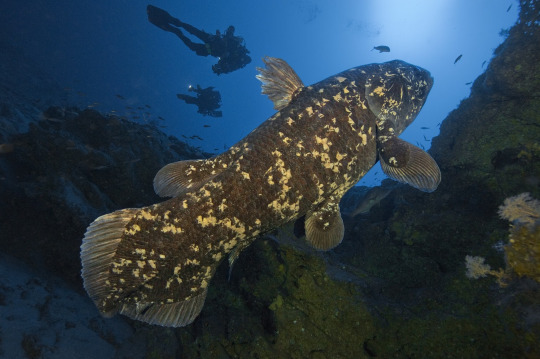
(image id: a wild coelacanth. It is a large, mostly grey fish with splotches of yellowish scales. Its fins are attached to fleshy lobes. It is seen from the side, facing the top right corner of the picture)
Coelacanth fossils had been known since the 1800s and they were believed to have gone extinct in the late Cretaceous period. That was until December 1938, when a museum curator named Marjorie Courtenay-Latimer was informed of an unusual specimen that had been pulled in by local fishermen. After being unable to identify the fish, she contacted a friend, ichthyologist J. L. B. Smith, who told her to preserve the specimen until he could examine it. Upon examining it early next year, he realized it was indeed a coelacanth, confirming that they had survived, undetected, for 66 million years. Note that fishermen living in coelacanth territory were already aware of the fish before they were formally described by science. Coelacanths are among the most famous examples of a lazarus taxon. This term, in the context of ecology and conservation, means a species or population that is believed to have gone extinct but is later discovered to still be alive. While coelacanths are among the oldest living lazarus taxa, they aren't the oldest. They are beaten out by a genus of fly (100 million years old) and a type of mollusk (over 300 million years old).

(image: a coelacanth fossil. It is a dark brown imprint of a coelacanth on white rock. Its skeleton is visible in the imprint)
Coelacanths are one of only two surviving groups of lobe-finned fish along with the lungfishes. Lobe-finned fish are bony fish notable for their fins being attached to muscular lobes. By contrast, ray-finned fish (AKA pretty much every fish you've ever heard of that isn't a shark) have their fins attached directly to the body. That may not sound like a big difference, but it actually is. The lobes of lobe-finned fish eventually evolved into the first vertebrate limbs. That makes lobe-finned fish the ancestors of all reptiles, amphibians, and mammals, including you. In fact, you are more closely related to a coelacanth than a coelacanth is to a tuna. Coelacanths were thought to be the closest living link to tetrapods, but genetic testing has shown that lungfish are actually closer to the ancestor of tetrapods.
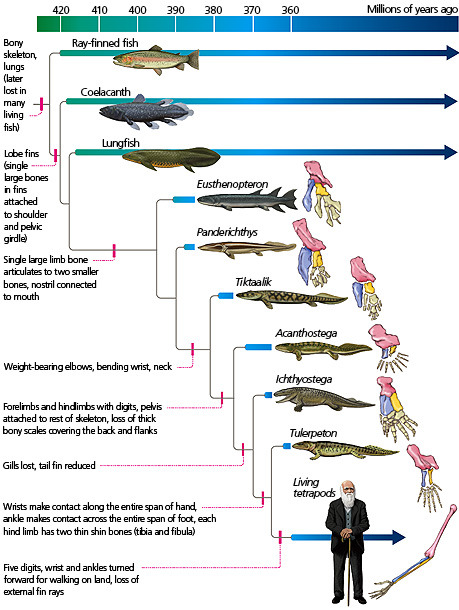
(image id: a scientific diagram depicting the taxonomic relationships of early lobe-finned fish showing their evolution to proto-tetrapods like Tiktaalik and Ichthyostega, to true tetrapods. Source)
There are two known living coelacanth species: the west Indian ocean coelacanth (Latimeria chalumnae) and the Indonesian coelacanth (L. menadoensis). Both are very large fish, capable of exceeding 2 m (6.6 ft) in length and 90 kg (200 lbs). Their wikipedia page describes them as "plump", which seems a little judgmental to me. Their tails are unique, consisting of two lobes above and below the end of the tail, which has its own fin. Their scales are very hard and thick, acting like armor. The mouth is small, but a hinge in its skull, not found in any other animal, allows the mouth to open extremely wide for its size. In addition, they lack a maxilla (upper jawbone), instead using specialized tissue in its place. They lack backbones, instead having an oil-filled notochord that serve the same function. The presence of a notochord is the key characteristic of being a chordate, but most vertebrates only have one in embryo, after which it is replaced by a backbone. Instead of a swim bladder, coelacanths have a vestigial lung filled with fatty tissue that serves the same purpose. In addition to the lung, another fatty organ also helps control buoyancy. The fatty organ is large enough that it forced the kidneys to move backwards and fuse into one organ. Coelacanths have tiny brains. Only about 15% of the skull cavity is filled by the brain, the rest is filled with fat.

(image id: a coalacanth. It is similar to the one on the above image, but this one is blue in color and the head is seen more clearly, showing an open mouth and large eye)
One of the reasons it took so long for coelacanths to be rediscovered is their habitat. They prefer to live in deeper waters in the twilight zone, between 150 and 250 meters deep. They are also nocturnal and spend the day either in underwater caves or swimming down into deeper water. They typically stay in deeper water or caves during the day as colder water keeps their metabolism low and conserves energy. While they do not appear to be social animals, coelacanths are tolerant of each other's presence and the caves they stay in may be packed to the brim during the day. Coelacanths are all about conserving energy even when looking for food. They are drift feeders, moving slowly with the currents and eating whatever they come across. Their diet primarily consists of fish and squid. Not much is known about how they catch their prey, but they are capable of rapid bursts of speed that may be used to catch prey and is definitely used to escape predators. They are believed to be capable of electroreception, which is likely used to locate prey and avoid obstacles. Coelacanths swim differently than other fish. They use their lobe fins like limbs to stabilize their movements as they drift. This means that while coelacanths are slow, they are very maneuverable. Some have even been seen swimming upside-down or with their heads pointed down.
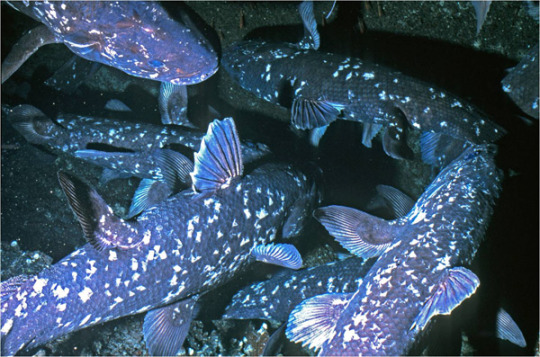
(image: an underwater cave wilt multiple coelacanths residing in it. 5 are clearly visible, with the fins of others showing from offscreen)
Coelacanths are a vary race example of bony fish that give live birth. They are ovoviviparous, meaning the egg is retained and hatches inside the mother. Gestation can take between 2 and 5 years (estimates differ) and multiple offspring are born at a time. It is possible that females may only mate with a single male at a time, though this is not confirmed. Coelacanths can live over 100 years and do not reach full maturity until age 55. This very slow reproduction and maturation rate likely contributes to the rarity of the fish.

(image: a juvenile coelacanth. Its body shape is the same as those of adults, but with proportionately larger fins. There are green laser beams shining on it. These are used by submersibles to calculate the size of animals and objects)
Coelacanths are often described as living fossils. This term refers to species that are still similar to their ancient ancestors. The term is losing favor amongst biologists due to how misleading it can be. The term os often understood to mean that modern species are exactly the same as ancient ones. This is not the case. Living coelacanth are now known to be different than those who existed during the Cretaceous, let alone the older fossil species. Living fossils often live in very stable environments that result in low selective pressure, but they are still evolving, just slower.
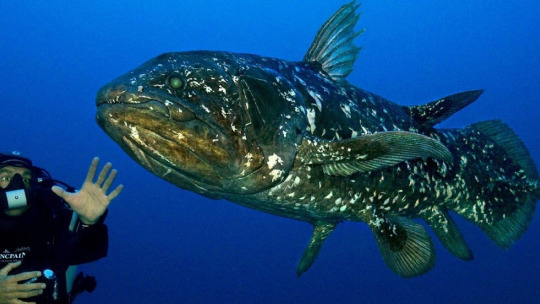
(image: a coelacanth swimming next to a SCUBA diver)
Because of the rarity of coelacanths, it's hard to figure out what conservation needs they have. The IUCN currently classifies the west Indian ocean coelacanth as critically endangered (with an estimated population of less than 500) and the Indonesian coelacanth as vulnerable. Their main threat is bycatch, when they are caught in nets intended for other species. They aren't fished commercially as their meat is very unappetizing, but getting caught in nets is still very dangerous and their slow reproduction and maturation means that it is long and difficult to replace population losses. There is an international organization, the Coelacanth Conservation Council, dedicated to coelacanth conservation and preservation.
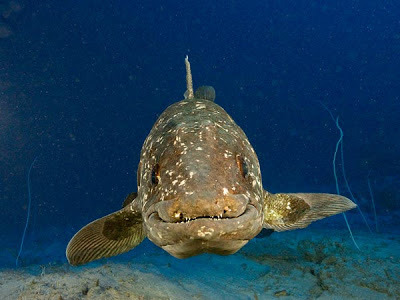
(image: a coelacanth facing the camera. The shape of its mouth makes it look as though it is smiling)
#wet beast wednesday#coelacanth#marine biology#biology#zoology#ecology#animal facts#fish#fishblr#old man fish#lobe-finned fish#sarcopterygii
1K notes
·
View notes
Text
Humans are weird: Ramming Speed
( Please come see me on my new patreon and support me for early access to stories and personal story requests :D https://www.patreon.com/NiqhtLord Every bit helps)
The idea of ramming space ships into each other as a form of combat maneuver was beyond many galactic military minds comprehension.
A single spacecraft, let alone a military grade class vessel, would cost up in the billions of credits. Entire galactic economies had nearly bankrupted themselves trying to maintain a fleet large enough to secure their borders, so in turn each military ship became an asset not to be squandered lightly.
Perhaps it was this conservative mindset that nearly shattered when these powers first looked upon the Terran ship codenamed “The Ram”.
Unlike other modern vessels the ships of this new classification lacked all weapon emplacements. No energy cannons, missile launchers, rail guns; it was entirely free of weapons. What it did have was excessive amounts of armor plating, several separate shield generators, and a pair of overly powerful engines that could reach max speed in roughly five minutes.
The first time it was observed in combat was during the Terran/Crux war. Both powers had sizable fleets at their disposal and for the first couple months the two powers played cat and mouse games between each other; each trying to find a more advantageous position to commit their forces. Much to the dismay of both powers the first large scale battle was triggered by mere chance than a tactical decision.
A Crux patrol stumbled upon a Terran patrol emerging from a dense nebula in the Viper System. Both patrols requested reinforcements. Nearby patrols were soon diverted to the engagement and within short order what was a small skirmish ballooned into a full scale battle.
There were no battle lines or frontlines as ships opened fire at near point blank range with each other. Even when higher rank Admirals arrived to take charge both sides were too embroiled in the slugfest to make any more nuanced tactical moves without exposing themselves to the enemy.
It was here that the Ram emerged and showed its prowess.
Crux warship crews were not trained on how to handle enemy vessels rushing towards them. What’s more several gun crews became panicked when they saw the Ram ships rushing headlong towards them without diverting course.
With the extra armor and shielding the Terran ships not only struck head on into Crux ships but emerged from the attack relatively unscathed. In most cases the prow of the Ram ships punched clean through the entire hull of the Crux warship and emerged through the other side.
The Crux fleet desperately tried to regain order and form battle lines but each time they did so the Ram ships would plunge head first into their formation and take out the command ship coordinating the effort.
As more and more Terran ships arrived and formed their own battle lines the tide of battle soon drastically changed. After thirteen hours of intense fighting the last of the Crux fleet withdrew from the battle leaving the Terrans the victors.
A full fifth of the Crux navy was lost during the battle with the Ram ships having personally claimed 45% of the kills.
While the war itself would continue for another two years, the Ram ships and their unorthodox tactics had earned them a modicum of respect from the wider galaxy, and a great measure of fear from the Crux.
#humans are insane#humans are weird#humans are space oddities#humans are space orcs#scifi#story#writing#original writing#niqhtlord01
331 notes
·
View notes
Note
For a long time now, it's been impossible to see comments or reblogs with comment/tags on posts over a certain age when using the mobile app or blog view. Today I was looking at a post from 2015 that I knew had at least one reblog comment and lots of tags, but all the reblogs were under "other". I found the comment (but couldn't see any tags) by going to the [blog name].tumblr.com/post/[###] link and scrolling through all the notes in one list, but it's impossible anywhere else.
I know this probably has to do with the many changes Tumblr has gone through in that time, but it's still really inconvenient to have disappearing notes on the platform where part of the charm is that posts can survive for, at this point, almost a decade and a half.
Is it even possible to fix this, and of so, is it something you would consider?
Answer: Hey there, @maplerosekisses!
It is possible to fix this, and we would like to fix it, but it’s a daunting problem at Tumblr’s scale. Buckle up for storytime.
Long, long ago, Tumblr was created, and in the beginning, there weren’t even notes on posts. There weren’t even reblogs or likes. In fact, we were one of the first platforms to introduce the heart icon and the concept of “likes”! We created the reblog! Back in those days, each of these actions were tracked separately. Likes were tracked in one database table and reblogs weren’t tracked at all as notes. When we introduced replies, those had yet another way of being tracked in our database. Totally separate entities on the platform for years.
Eventually, we wanted to consolidate these into one number—so we had to count each of those different places. That’s horribly inefficient, and as Tumblr grew in size and popularity, this became a bottleneck that hurt the whole platform. So one of the things we did was to invent a new denormalized database table called “notes,” to track all of these different things in one place so we could easily count them. We still have that table, and it’s still the fallback whenever we need to count the notes on a post.
But this itself is ancient history. Since then, the product has changed even more, and we removed replies and re-added them later, back in 2015 or so—and made some changes in that process to help further improve efficiency. These improvements allowed us to include media in the notes view, and be able to split out replies versus reblogs-with-comment versus likes (kind of going back to the way it was originally.) Even then, we didn’t yet support showing tag usage in the notes—that would come even later.
In the process of making all of these changes for efficiency and functionality, we had to ask ourselves, as you point out: should we try to backfill these new database tables with all of the data from before? For a long while, we were using both systems to power the notes view, so we could display as much information from “before” as we could. Eventually, we didn’t need to do that anymore, because the number of people scrolling back to that “before” time became infinitesimally small. And that's the situation we’re in today.
Because if we wanted to backfill the data, we would need to process literally tens of billions of posts and notes from before 2015, at a conservative estimate. Let’s say it’s 10,000,000,000, for the sake of argument: if we started an automated process to go through them at ~100 per second (which would be relatively safe at our scale, so Tumblr doesn’t break as we’re digging up these old rows in the database), it would take over three years of continuous operation to complete that task.
In situations like this, we have to ask ourselves if that’s worth it. So far, the answer we’ve determined is no. But we may find a more efficient way to do it, there’s undoubtedly a way, and when we do, we will re-evaluate the decision again. We hope that makes sense—trying to make changes to Tumblr can be really, really hard.
But thank you for your question. We appreciate them and hope that goes some way to answering your query. Keep 'em coming, y'all.
269 notes
·
View notes
Text

I was asked to provide a guide to the Celestial Hierarchy, so this is a very rough guide, with certain details omitted for various reasons.
The ‘alt text’ thingy didn’t seem willing to contain a full description, so I include it below:
An attempt at describing the informative ‘graphical’ representation.
The image describes the Hierarchy of Heaven, with the titles of angelic choirs and notes on their roles and functions.
God is, of course, at the top (although in a more dimensionally accurate depiction, this would be the centre).
Beneath God is the Metatron - Voice of God. The appended note reads ‘TECHNICALLY PART OF THE SERAPHIM’ but further information is blocked out with ‘REDACTED’ in its place.
There are three groups of angels below Metatron. They are the First, Second and Third Spheres.
The First Sphere includes Seraphim, Cherubim and Thrones.
The following notes are attached:
1: ARCHANGELS (this is written with a capital A)
Senior management, drawn from the ranks of Seraphim and Cherubim.
Theirs are CENTRE-FACING ROLES (Enacting the Will of God, facilitation of the Plan, long-term strategies and Angelic Resources).
2: As a point of etiquette, Seraphim and Cherubim are only to be spoken of as a plurality. Do not refer to one Seraph or one Cherub.
3. Cherubim are not to be confused with Cherubs — young/neonate angels, or cherubs — quasi-sentient firmament devices. (The word ‘cherub’ is written with strangely accented letters, suggesting that the words may sound different.)
Thrones have their own role description: LOGISTICS & LARGE-SCALE
MACROCOSMIC FORCES, and an additional, emphatic note: NO WHEELS. NONE OF US HAVE WHEELS.
The Second Sphere includes Dominions, Virtues and Powers.
The role description for Dominions and Virtues reads: ARCHITECTS. ENGINEERS, FIRMAMENT-SMITHS, but the description beside Powers has been redacted.
The Third Sphere includes Principalities, archangels (with a small a) and Angels.
A note on etiquette regarding archangels reads ‘don’t forget the small a. But don’t bring it up in conversation’.
This Sphere is characterised as ‘EARTH-FACING ROLES & ADMINISTRATION — Guidance, observation, soul-conservation & procurement, record-keeping’.
A note on Principalities warns ‘Don’t make jokes about how few of them there are’ and ‘This means you, Sandalphon.’
Conversely, regarding Angels, the advice says ‘There are so many of them. Millions. Don’t try to remember every name when you can generally get away with ‘Mumble-iel’.
#good omens#good omens 2#The Hierarchy of Heaven#informational graphic image#don’t rely on Ezekiel#Pseudo-Denys was drunk#although to be fair so was I
422 notes
·
View notes
Text
Seven thousand more UAW members just walked off the job, expanding the strike to two more plants. Twenty-five thousand autoworkers are now on strike, and the walkout could continue to escalate if the Big Three don’t budge in negotiations.
[UAW president Shawn] Fain announced that Stellantis would be spared this time. The union had been expected to strike all three companies, but, said Region 1 director LaShawn English, three minutes before Fain was scheduled to go on Facebook Live, the UAW received frantic emails from company representatives.
[Note: Love that for the UAW. Also laughing so hard. Three minutes before the next round of strikes were annouced!!]
According to Fain, Stellantis made “significant progress” on cost-of-living allowances, the right not to cross a picket line, and the right to strike over product commitments and plant closures. “We are excited about this momentum at Stellantis and hope it continues,” Fain said...
“See You Next Week — Maybe?”
“These guys wanted to go out a long time ago,” said Cody Zaremba, a Local 602 member at the Lansing GM plant after the news broke that his plant would be joining the strike. “We’re ready. Everybody, truly, I believe, in the entire membership. They’re one with what’s going on.”
Five thousand workers at thirty-eight parts distribution centers across twenty-one states have been on strike since last Friday [September 22, 2023], along with thirteen thousand at three assembly plants in Michigan, Ohio, and Missouri who walked out on September 15. (See a map of all struck facilities here.) ...
The UAW is now calling on community supporters to organize small teams to canvass dealerships that sell and repair Big Three cars and trucks. On Tuesday, the union issued a canvassing tool kit with instructions, flyers, press releases, and talking points.
In negotiations with Ford and GM, autoworkers have clinched some important gains. Among them is an agreement by both companies to end at least one of the many tiers in current contracts, putting workers at certain parts plants back on the same wage scale as assembly workers. The top rate for Big Three assembly workers is currently around $32...
Ford was spared in last week’s escalation, because bargainers there had made further progress on gains for workers.
But today, the UAW once again called out workers at Ford and GM, putting some muscle behind its bold demands — a big wage boost, a shorter workweek, elimination of tiers, cost-of-living adjustments tied to inflation, protection from plant closures, conversion of temps to permanent employees, and the restoration of retiree health care and benefit-defined pensions to all workers.
-via Jacobin, September 29, 2023. Article continues below.
Keep Them Guessing
This year, for the first time in recent history, the union has played the three auto companies against each other with its strike strategy, departing from the union’s tradition of choosing one target company and patterning an agreement at the other two.
The stand-up strike strategy draws inspiration from an approach known as CHAOS (Create Havoc Around Our System), first deployed in 1993 by Alaska Airlines flight attendants, who announced they would be striking random flights. Although they struck only seven flights in a two-month period, Alaska had to send scabs on every plane, just in case. The unpredictability drew enormous media attention and drove management up the wall. Meanwhile the union was able to conserve its strength and minimize risk.
The companies miscalculated where the UAW was going to strike first, stockpiling engines and shipping them cross-country to the wrong facilities. Autoworkers relished the self-inflicted supply chain chaos on UAW Facebook groups and other social media platforms.
Nonstrikers’ morale on the factory floor has gotten a boost from rank and filers organizing to refuse voluntary overtime. With support both from Fain and the reform caucus Unite All Workers for Democracy (UAWD), workers have been encouraging each other to “Eight and Skate,” meaning to turn down extra work and decline to do management any favors.
Majority Public Support
A majority of Americans support the UAW strikers, and the Big Three have taken a PR hit since the strike began, according to a new survey conducted by the business intelligence firm Caliber.
“Eighty-seven percent of respondents told us they were aware of the strike,” Caliber CEO Shahar Silbershatz told the Intercept. “It’s clear the strike is not just causing commercial repercussions, but reputational repercussions as well.”
These reputational repercussions will only worsen...
"We Can Unmake It"
Fain didn't pull any punches in his speech... “That’s what’s different about working-class people. Whether we’re building cars or trucks or running parts distribution centers; whether we’re writing movies or performing TV shows... we do the heavy lifting. We do the real work. Not the CEOs, not the executives.
"And though we don’t know it, that’s what power is. We have the power. The world is of our making. The economy is of our making. This industry is of our making.
“And as we’ve shown, when we withhold our labor, we can unmake it.”
-via Jacobin, September 29, 2023
#united states#us politics#organized labor#uaw#uaw strike#united auto workers#auto workers#labor rights#uaw strong#worker rights#unions#labor unions#strike#unionize#auto industry#ford#general motors#stellantis#working class#cars#michigan#ohio#missouri#solidarity forever#hot labor summer
466 notes
·
View notes
Note
Do you have any cool facts about Missouri wildlife?
I'd love to share something with my Midwestern friends, and thank you for always updating this blog!
I don't know if i have any Missouri animal facts per se... but I can share some of the state symbols with everyone.
We moved around a lot when we first came to the U.S. and we lived briefly in Kansas City. I have great memories of going to the Ozarks at Christmas time (near Lake of the Ozarks). I specifically remember following woodpeckers and deer around the forest in the snow.
SOME MISSOURI STATE SYMBOLS:
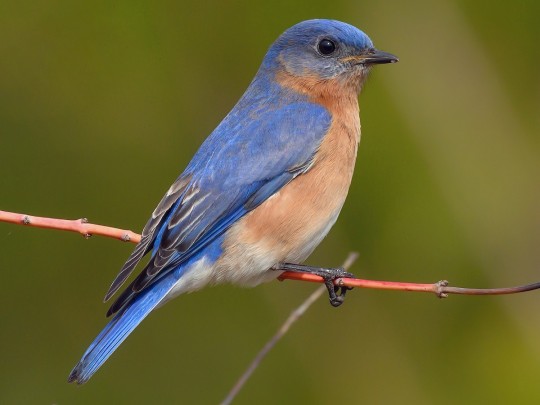
STATE BIRD: Eastern Bluebird (Sialia sialis), family Turdidae, order Passeriformes, found across much of the central and Eastern U.S., SE Canada, and NW Mexico
Changes in land use lead to drastic declines in Eastern Bluebirds after the early 1900s. They have recovered in many places, due to "bluebird trails", reestablishing appropriate habitat and nest box campaigns for public and private property.
Find out more: NestWatch | Eastern Bluebird - NestWatch
Blue birds are in the thrush family, Turdidae, along with American Robins.
They eat mainly worms, insects, and other small invertebrates (but also take berries for part of the year).
Bluebirds are cavity nesters, nesting in tree holes usually, but will readily take to properly constructed and placed nest boxes.
Males (pictured) are brighter blue, and females are a more muted and faded blue or bluish gray.
photograph by Keith Kennedy

STATE AQUATIC ANIMAL: American Paddlefish (Polyodon spathula), family Polyodontidae, order Acipenseriformes, found in various parts of the Mississippi River basin
This species is the only member of this family that still exists. They are most closely related to sturgeons. This order, Acipenseriformes, is considered one of the most evolutionarily primitive groups of ray finned fishes.
They do not have scales, and their skeleton is mostly cartilaginous.
They are filter feeders. Their heads and rostrums are covered with thousands of sensory receptors, which help them locate zooplankton swarms.
They are considered "vulnerable" due to overfishing, habitat degradation and destruction, and pollution.
photograph via: US Fish & Wildlife Service
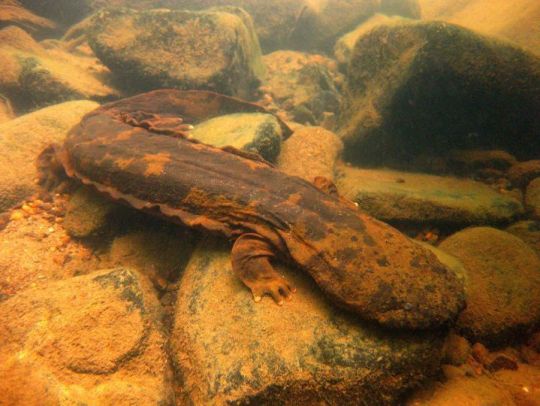
STATE ENDANGERED ANIMAL: Eastern Hellbender (Cryptobranchus alleganiensis), family Cryptobranchidae, eastern United States
The largest salamander in the Americas, it grows to a total maximum length of up to 40 cm (15.7 in).
Though nationally it is considered to be just "vulnerable", in some states (like Missouri), it is "endangered".
photograph by Mark Tegges

STATE REPTILE: Three-toed Box Turtle (Terrapene triunguis), family Emydidae, found in the South-central and Southeastern U.S.
This specie shas been considered to be a subspecies of the Eastern Box Turtle, T. carolina (and still is by some herpetologists).
These turtles are terrestrial, but are not closely related to tortoises. They are in the same family as aquatic sliders, pond turtles, cooters, map turtles, and painted turtles.
photograph by Noppadol Paothong
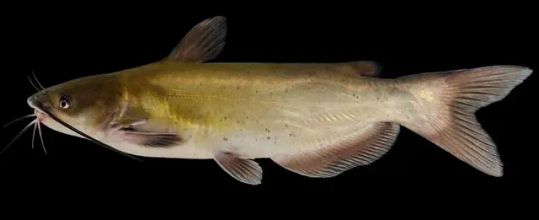
STATE FISH: Channel Catfish (Ictalurus punctatus), family Ictaluridae, order Siluriformes, found in freshwater habitats in the eastern and southern US, southern Canada, and northern Mexico
They are widely caught, and have been introduced into waterways in other parts of North America and around the world. (In some places they are considered an invasive species).
photograph via: Missouri Dept. of Conservation

photograph by Brian.gratwicke
#Acipenseriformes#paddlefish#fish#ichthyology#box turtle turtle reptile#herpetology#bluebird#thrush#bird#ornithology#north america#hellbender#salamander#amphibian#animals#nature#catfish
177 notes
·
View notes
Text
a soft place to fall
summary: the softest place to fall would always be into Nikolai's arms (or three times Y/N fell and Nikolai caught her)
a/n: it's been a minute

"Well, that's not foreboding," Nikolai said, leaning on the side of the Volkvolny.
The island loomed before them, the tops of the mountains covered in cloud. The sky darkened as they approached, the sun disappearing completely.
"It could be anywhere in there," Tolya muttered, stretching out, trying to get a better look.
"It's there," Mal said a beat later, pointing to a small, almost invisible, opening in the bottom of the island.
Y/N huffed out a laugh, quickly trying to cover it as a cough when Tolya turned to her with an offended look.
"We're going a shore!" Nikolai yelled, slapping the side of the boat once.
Ten minutes later, Y/N found herself knee deep in cold water, her heart thrumming away in her chest. She was terrified. The Sea Whip might not even be real, but the tension and anxiety was so thick amongst their little group, that every little sound set them all off.
She knew, deep down, that she would be able to handle whatever happened. But it didn't help her nerves.
"You alright?" Nikolai asked softly, the sleeve of his jacket brushing against Y/N's arm.
"Ahuh," Y/N nodded, "just... nerves."
Nikolai nodded and gave her a quick, blinding smile. "We've got you, don't worry."
He reached down and squeezed her hand briefly. Y/N inhaled sharply, trying to ignore the butterflies soaring inside her at the slightest touch from Nikolai.
A pebble fell down from the roof and as Y/N tilted her head up, she caught a glimpse of yellow, slitted eyes and dark green scales. The Sea Whip lurched forward, snatching one of their crew mates up in its jaws and yanking it up and through a hole in the roof of the cave.
Y/N fell back, catching herself on the rocks. The rest of the group turned and began firing the pistols and rifles up at the ceiling.
"Stop!" Alina cried. "Don't hurt it."
The gunfire stopped but no one lowered their weapons, keeping them trained on the roof of the cave. Y/N's heart was pounding in her chest, her hands shaking as she held her revolver tightly.
"Where's it gone?" Nikolai asked, his eyes searching the roof frantically.
Y/N felt something vibrate against the ground and the water sloshed against the back of her legs. She turned and, as she did so, the man who had been standing behind her was yanked backwards and under the water.
"It's here!" She yelled, stepping backwards as quickly as she could in the water without tripping over.
Alina brushed past her, standing where the Sea Whip had just been, her hand hovering over the water. The silence was deafening. For a moment, no one moved. No one spoke.
The Sea Whip suddenly dived down from the ceiling again. Mal lurched forward and pushed Alina aside. Y/N was frozen to the spot, the scales of the Sea Whip glinting in the dim light as the whipped towards her.
A hand yanked her to the side and she lost her footing, falling into the water. Y/N scrambled to her feet, shooting Tamar a grateful look for pulling her out the way.
"It's playing with us," Nikolai said, standing up as quickly as he could and pulling Y/N to her feet as well. "Conserve your ammo!"
The Sea Whip launched out of the water again.
Y/N saw the tail coming towards her. She threw herself to the side, falling into the water and disappearing under it, the Sea Whip's tail smashing into the water above her head. Her vision became obscured by dozens of bubbles, the water clouding over.
Y/N couldn't find the way up, she couldn't see, she couldn't breathe. The Sea Whip was still swimming about, it's body bumping against Y/N's.
Hands came under her arms and yanked her to the surface. Y/N gasped loudly, gulping the air down gratefully. She knew it was Nikolai. Nothing could disguise the scent of his cologne - the feeling of his hands against hers, the way he squeezed her arms once, trying to reassure her.
Y/N gripped the sleeve of his jacket tightly as she coughed, her throat burning. As the Sea Whip shot up from the water again, it launched at Mal. He blocked the attack with his rifle, wedging it in its jaws. Alina then shot out a blast of light, killing the Sea Whip instantly.
It flopped into the water and then slowly floated to the top, smoke wafting up from where Alina had hit it.
Y/N stared at it, still half submerged in the water, Nikolai's arms wrapped around her tightly. She swallowed and then abruptly started coughing again.
"Hey," Nikolai said, looking down at her. "Are you ok?"
Y/N swallowed, panting slightly. She nodded. "Fine."
"Tolya," Nikolai called.
"I'm fine -"
"I just want to check," Nikolai placated, squeezing her hand. "Before I make you drag this thing back to the boat."
Y/N rolled her eyes at him, but her smile gave away her amusement. "Funny, Nik."

"It's so choppy!"
"Way to state the obvious."
Nikolai gave Y/N a glare - one that was entirely ignored as she grinned back at him.
She was gripping on tightly to one of the main ropes hanging down from the main mast. Waves kept smashing up against the side of the boat, water sloshing over the edges. It was nearly impossible to remain upright and everyone was wet.
Yet Y/N was beaming, enjoying every single second. Nikolai, gripping onto the steering wheel tightly, watched her as she all but crawled further up the boat, going to help one of the crew tie off a rope.
He sometimes wished he could have an ounce of Y/N's joy. It might make life easier.
"Brace!"
Nikolai gripped the steering wheel even tighter, ducking down behind it slightly, as another wave smashed into the front of the ship. The front of the ship tipped up, struggling to ride the wave.
The ship slammed down abruptly, water splashing up from the bow of the ship. Nikolai pushed himself up on the wheel, surveying the damage with a hesitant gaze.
Everything looked to be in tact... ish.
"That was fun," Y/N said, carefully walking over to him, her stance wide to counter the constant bouncing of the ship.
A particularly hard wave smashed into the ship, knocking it to the side. Y/N let out what had to be an involuntary shriek, for Nikolai had never heard her make a noise like that before, and fell forward.
Nikolai opened his arms, braced himself, and caught Y/N. Her body slammed into his and he grunted, taking a step back to brace himself.
"Sorry," Y/N winced, putting her hands on his chest as she pushed herself back onto her feet.
Nikolai smiled crookedly, trying not to look down at her hands, feeling their warmth through his soaking wet jacket and shirt. "Don't be."

"Everyone alive?" Nikolai called, pushing himself up onto his haunches, eyes frantically scanning the occupants of the ship.
Numerous grunts gave Nikolai his answer. He winced as he put his weight on his injured leg, blood staining his trousers. Dominik rushed to his side, taking his arm and putting it on his shoulders.
"You need to sit down," Dominik said, taking almost all of Nikolai's weight.
"No, we need to get off this boat," Nikolai panted. He was looking around the destroyed ship, at the bodies, the burnt metal, the chunks of tree littering the deck. "They're coming for us."
Dominik helped Nikolai climb down from the boat, navigating the broken trees and the dead bodies in their path.
"Wait," Nikolai said, halting abruptly, pushing away from Dominik. "Y/N, where's Y/N?"
"Here," Y/N called weakly, wobbling as she stumbled on a loose log. She took another unsure step and her foot slipped, rolling on a stone.
Y/N lurched forward. She mentally braced herself to land in the grass but a pair of arms caught her, holding her tightly to them.
Her eyes flew open and she stared up at Nikolai. They looked a wrecked, both covered in blood, grime and sweat. Yet he'd never looked so beautiful to her. Because he was still here, alive, and holding her.
"You okay?" He asked quietly, the tips of his fingers pressing against her back. He wobbled and Dominik silently put a hand against his back, steadying him.
Y/N nodded, her hand resting on his wrist, her thumb rubbing against his skin gently. "Yeah."
"Nik, we need to go," Dominik urged gently.
Nikolai suddenly snapped back into life, the young soldier and privateer taking over. "Nadia, Adrik, head for the trees and up that hill!" He yelled. "Come on!"
Wordlessly, Y/N put a hand on Nikolai's waist. He instinctively put his arm around her shoulders and, together (with some help from Dominik) the awkwardly limped as fast as they could up the hill and into the trees, leaving the wrecked ship smoking behind them.
#nikolai lantsov#nikolai lantsov x reader#nikolai lantsov x female reader#shadow and bone fic#shadow and bone#shadow and bone imagine#shadow and bone x reader#fic#fanfic#nikolai lantsov imagine
754 notes
·
View notes
Text

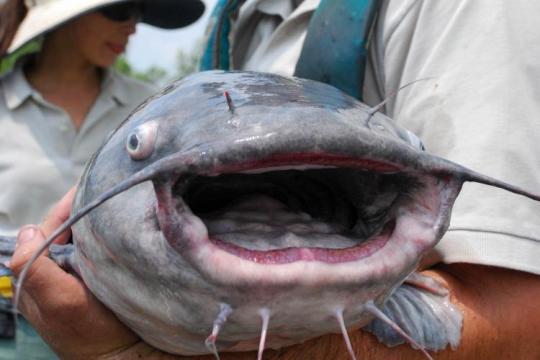
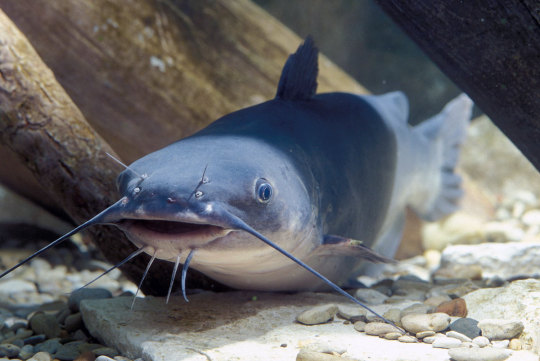
The Beautiful Blue Catfish
Blue catfish (Ictalurus furcatus) are members of the bullhead catfish family, native to the drainages of the Mississippi, Missouri, and Ohio river basins and the Gulf of Mexico. Because of their popularity as game fish, this species has also been introduced to freshwater systems throughout North and South America, and is considered invasive in these areas.
Like many catfish, I. furcatus is a bottom dweller. They can often be found near complex structures such as rocky outcroppings, fallen trees, or sunken structures that provide both food and shelter. The blue catfish is an opportunistic predator, consuming any fish or aquatic invertebrates it can find, as well as eggs, small amphibians, and injured or recently deceased animals. Adult I. furcatus are seldom prey for other species due to their size, but hatchlings and juveniles are often food for cormorants, willets, osprey, pelicans, and bald eagles. To deter predators, this species has serrated barbs along their dorsal and pectoral fins, each laced with a particularly painful toxin.
Though they can be difficult prey for other animals, the blue catfish is a popular target for fishermen, and for good reason; they're the largest species of catfish in North America. Adults can easily reach a length of 65 in (170 cm) and a weight of 165 lb (75 kg). As indicated by their name, most individuals are grey or blue, with a lighter underbelly. This species also lacks scales, a common characteristic of catfish, and the face is framed by long whisker-like barbels that help it detect nearby food.
While generally solitary, blue catfish aren't territorial, and tend to ignore each other until the mating season. Reproduction begins in April and continues until June, during which time males attract a female by building a nest and releasing attractive pheromones. Once a female has selected a male, she lays between 4,000-8,000 eggs per kilogram of bodyweight in his nest (i.e. if the female weighs 2 kg, she may lay between 8,000-16,000 eggs). The male then disperses sperm over the eggs. Following fertilization, the male chases away the female and guards the nest for about a week, at which time the eggs hatch. The hatchlings, also known as fry, stay close together in schools for several weeks before growing large enough to disperse. It will take them a further 5 years for them to reach maturity; on average individuals live about 10 years, but can live as long as 25.
Conservation status: The blue catfish is considered Least Concern by the IUCN. Within its native range, populations face minor threats from dams and droughts. Where it has been introduced, the species is considered invasive due to its voracious appetite.
If you like what I do, consider leaving a tip or buying me a ko-fi!
Photos
Missouri Department of Conservation
NOAA
Earl Nottingham
#blue catfish#Siluriformes#Ictaluridae#ictalurids#catfish#ray finned fish#bony fish#fish#freshwater fauna#freshwater fish#rivers#river fish#lakes#lake fish#north america#southern north america
218 notes
·
View notes
Text
This is The Farming Left: these land workers share a politics, united by the concept of food sovereignty: the right to control of local food systems, which originated with farmers in the Global South. ‘We’re talking about equitable access to resources to enable localised food supplies’, explains Fernandes. These organisations are tackling the challenges of access to land in an unequal landscape: the Ecological Land Cooperative, for example, purchases large plots and obtains planning permission for dwellings before parcelling them up into affordable smallholdings.
The Kindling Trust in Manchester is also seeking to foster a new generation of agroecological farmers. The Trust, which was established in 2007, has a veg box scheme and a community garden, and also offers training to new entrants, but there has always been a long-term plan to establish a cooperative farm. Since raising over a million pounds from more than six hundred investors last year, the Trust is looking to purchase a 120-acre farm in the Manchester area. ‘We want people to feel ownership in whatever way they get involved’, explains co-founder Chris Walsh. Whether they are founding members, workers, investors, or tenants, they will all be represented equally on a governing board.
There ‘is a need for a rural radicalism’ of this kind, argues Chris Smaje, farmer and author of A Small Farm Future (2020). ‘It’s about trying to de-commodify land and take it out of speculative ownership’, he explains. For Smaje, who plans to purchase a 20-acre plot to be divided up among several small-scale farmers, the goal is ‘to build a land-based community’ and ultimately ‘generate more of what we need within our own communities’.
While the radical agrarian community in the UK pales in comparison to the strength of conservative farming interests, this fight for land – and the right to use it – is happening on a global scale. The international peasants’ movement is connected through the 200-million strong La Vía Campesina, linking groups such as Brazil’s Movimento dos Trabalhadores Rurais Sem Terra (MST), or ‘Landless Workers’ Movement’, which has, since the 1980s, been occupying land to their counterparts across the world. The world’s farming Left is a David to big agribusiness’s Goliath, the latter having been bolstered by states, major international institutions, and the liberalising of global political economy since the Second World War. From Zapatistas to Scottish crofters, the peasants’ movement is fighting to turn the tide on our social and ecological future before it is too late.
82 notes
·
View notes
Text
here's my controversial plant opinions of the day:
your garden can be both native and non-native plants. Its fine. It is not evil to plant non-native plants. Avoid invasives and noxious weeds but many non-native plants are good and fun
not all nativars are the Worst Ever or completely useless for pollinators the way many people claim BUT they do lower genetic diversity if cloned and not seed bred. This is more an issue if you are trying to reestablish a wild area or preserve a species, less so if you are landscaping your suburban house
Not all non native plants growing wild need to be eradicated or are horribly invasive, especially if they are growing in disturbed areas that we created. Hesperis matronalis for example grows places like roadsides, train tracks, and areas where invasives have already choked out natives.
Invasive plants are a symptom of a problem, not a problem themselves. They are not evil. It does not do any good to assign moral worth to plants. Native plants are not "good". Invasive plants are not "the enemy" They just are. They are filling a niche that our society left open for them.
If you are going to remove invasive plants en masse, you have to have a plan for whats going in its place. Garlic mustard, for example, tends to build up in population and then decline in number... unless the population is disturbed in which case it starts back up again.
Given that climate change is a thing and the fact that we have changed the environment on a micro level by putting in dams and streets and neighborhoods with lawns and shopping centers.... most definitions of native plants are bogus. The idea that traditonal native plants are better adapted to our local environment is no longer true. The winters are getting colder, watersheds are changing all the time, and your new development with all the topsoil shaved off in the baking sun with so much deer pressure even deer resistant plants don't stand a chance... the native plants are not native to that environment.
Oh, the problem is capitalism btw. Our infrastructure and livelihoods depend on creating environments where invasives thrive and natives cannot.
Individuals can help on a very small scale by planting their yards in an environmentally friendly way but if a highway project and new industrial center is going in down the street... nothing is going to help the local environment except lobbying and supporting conservation organizations
4K notes
·
View notes
Video
youtube
Amorgorama [Αμοργόραμα]: a genuine communal vision for the preservation of the seas.
The short film, or audiovisual slideshow of this post is the first part of the series that will be shot on the field in the coming months, closely following the bottom-up [1] marine conservation and fisheries management initiative of the local Small Scale Fishers of Amorgos in the Aegean Sea. A few months ago I had published another post which provided limited information on this project, now the time has come to properly highlight it!
This novel initiative-Amorgorama- seeks the legislation of spatial conservation measures from the Greek competent fisheries authorities for the protection of Amorgos' seas. It further appeals for the establishment of a participatory administrative scheme, based on fisheries co-management principles [2] for the overall sustainable management of the fishery sector of Amorgos and its surrounding marine area.
The phenomenal abundance of fishery products marketed and consumed in unprecedented quantities throughout the globe is only superficial, while fish-stock depletion and irreversible collapse of marine ecosystems have become more than evident on a worldwide scale. These blighted practices threaten not only the survival of countless species, but also the existence of coastal and insular human communities. Overfishing and the ceaseless degradation of the marine natural environment, through extractive, unsustainable and destructive human practices, pose now-a-days as some of the most important environmental issues to be urgently tackled. If humanity still wants to preserve the oceans and restore them to the blooming marine ecosystems they once used to be, direct and effective response is crucially needed.
This ill-fated state has been brought out not only by conservationists, activists and fisheries scientists, but also by fishers, especially small scale local professionals, heavily dependent on healthy marine ecosystems and thriving fish-stocks necessary for their livelihood. Small Scale Fisheries represent the majority of the EU fishing fleet (approximately 80%). They are particularly important in the Mediterranean Sea, where they have been playing a dominant role in the survival and nourishment of small insular and coastal communities for millennia. Typically, these are family-based businesses, where owners and their whole families are directly involved in the fishing activity. The small scale fishers of Amorgos have suffered over the last years a striking reduction in their incomes. This predicament was mainly induced by the rapidly declining and overfished fish-stocks, the degrading marine habitats, such as Posidonia meadows, coralligenous habitats and mäerl beds, all of which constitute key biodiversity hotspots and foremost nursery and fishing grounds, and the overwhelming and ubiquitous marine plastic pollution.
Amidst these grave circumstances, a local small scale fishing community has created Amorgorama, a shared, collective dream that has become the communal vision of Amorgos Island for a sustainable future both for fisheries and the marine natural environment. Amorgorama has inspired and is embraced by the entire local community and the local authorities of Amorgos, while it is supported by conservationists, the scientific and academic community, environmental NGOs, other stakeholders and authorities on a national and international scale. The fishers of Amorgos demand the designation of Marine Protected Areas (MPAs), particularly as no-take zones for fisheries in the northern shores of the island, a bimonthly temporary cessation of all fishing activities around the island between April and May, while during this period they will collect and recycle plastic litter and debris from the numerous inaccessible shores of the island with the use of their fishing vessels and caïques. Most importantly they plea for the establishment and operation of an effective and well-guarded MPA, and not the inauguration of a paper-park, a common mishap due to the persistent lack of political will by Greek policy makers.
A recent positive development that may apparently move marine conservation forward in Greek seas has been endorsed by the Greek government and its leadership. A year ago and during the IUCN World Conservation Congress in Marseille in France, the Greek PM explicitly expressed his will and commitment to actively accomplish the EU Biodiversity Strategy for 2030 [3], and particularly the 30 - 10 Protected Area targets (at least 30% of the sea should be protected in the EU, while 10% of EU seas should be strictly protected [4]) for the Mediterranean and Greek Seas. Consistent to the above declaration, the national competent authority for fisheries, the Ministry of Rural Development and Food, formally expressed its support to Amorgorama, reflecting thus a critical change in its overall fisheries management policy, which over the last decades remains rather conventional and narrow in terms of environmental conservation and nature protection. Thus, a Memorandum of Understanding was signed between all competent bodies, fishers, environmental NGOs and foundations, universities, local and regional authorities, confirming that the vision of Amorgorama is shared by all signatories and that the findings of a fisheries research study currently implemented in the targeted sites will become the main base for the designation of Marine Protected Areas and the future management of Amorgos’ fisheries.
Amorgorama is actively supported by the Cyclades Preservation Fund, the Blue Marine Foundation, the Municipality of Amorgos and the Agricultural University of Athens.
[1] The bottom-up approach aims: (i) to encourage a process of local participation; (ii) to involve the local community; (iii) to draw out ideas and generate initiatives; (iv) to build consensus and (v) to delegate decision-making powers to the local community and the involved stakeholders
[4] According to the Criteria and guidance for protected areas designations Commission’s Staff Working Document 28/01/2022-SWD(2022) 23 final: “In the context of the 10% target in the Biodiversity Strategy, strictly protected areas are defined as follows: “Strictly protected areas are fully and legally protected areas designated to conserve and/or restore the integrity of biodiversity-rich natural areas with their underlying ecological structure and supporting natural environmental processes. Natural processes are therefore left essentially undisturbed from human pressures and threats to the area’s overall ecological structure and functioning, independently of whether those pressures and threats are located inside or outside the strictly protected area”.
#Fisheries#MPAs#FRAs#SSF#Small Scale Fishers#Marine Biodiversity#EU2030#Amorgos#Marine Conservation#Marine Habitats#Marine Protected Areas#Fisheries Restricted Areas#Conservation#Science#Research#Cyclades#Aegean Sea#Mediterranean Sea#Amorgorama#Local Heroes#Bottom up#Fisheries Co-management#EU Biodiversity Strategy#EU Common FIsheries Policy#Sea#Natural Resources#Fish-stocks
1 note
·
View note
Note
Thank you for you blog! I love it so much - I come here daily to read your latest posts.
I'd love to own a snake but alas, I currently live in New Zealand so no snakes for me.
Do you have cool facts about tuatara? I do but I'd love readers of your blog to learn about these cool little reptiles!
It's a huge dream of mine to work with tuatara one day! I've always loved the reptile life of Oceania and literally the only reason I haven't already moved to Australia or even Aotearoa/NZ is because of the limitations on keeping non-native species.
Anyway, aren't tuatara just the coolest? For those unfamiliar, tuatara (Sphenodon punctatus) might look like lizards, but they're not! Tuatara are the only surviving members of Rhynchocephalia, the sister order to Squamata, the scaled reptiles (lizards, snakes, and amphisbaenians).

Rhynchocephalians used to be very widespread, but today they exist only in limited populations in Aotearoa. They were almost driven to extinction by habitat loss and pressure from invasive species, and for a long time the only wild populations were on offshore islands. In a huge success for tuatara conservation, though, populations were reintroduced onto the North Island and there are now hatchlings being born on the North Island for the first time in centuries. There's still so much work to be done to help these amazing reptiles, but it's worth celebrating! The Chester Zoo in England has also welcomed tuatara hatchlings, meaning tuatara have been successfully bred outside of Aotearoa for the first time and indicating possible future success for wider zoo breeding programs across the world!
Tuatara have many anatomical features that are unique among reptiles, and they tell us a lot about the extinct rhynchocephalians. Their teeth arrangement is unique among reptiles, and their lower jaws can slide to cut through bone. They're the only known amniotes who have hourglass-shaped vertebrae, and they have gastralia (belly ribs). Even if they might look kinda like lizards on the outside, their skeleton is wildly different!

Tuatara have the most well-developed parietal eyes of any vertebrates. These are "third eyes" that sit on top of the head, and in most reptiles who have them they're extremely primitive, but in tuatara they have well-developed retinas and a cornea-like structure! Parietal eyes are covered by a thin layer of skin and probably help with thermoregulation and day/night cycle regulation.

They are carnivores and eat a wide diet of insects, lizards, and birds. Juvenile tuatara will hunt during the day so they can avoid being eaten themselves by adult tuatara, who hunt at night.
The name "tuatara" comes from te reo Māori, and means "peaks on the back," a reference to the spines along a tuatara's back. Tuatara are sexually dimorphic, and the spines are larger and more rigid in males. They're used in breeding and defensive displays!
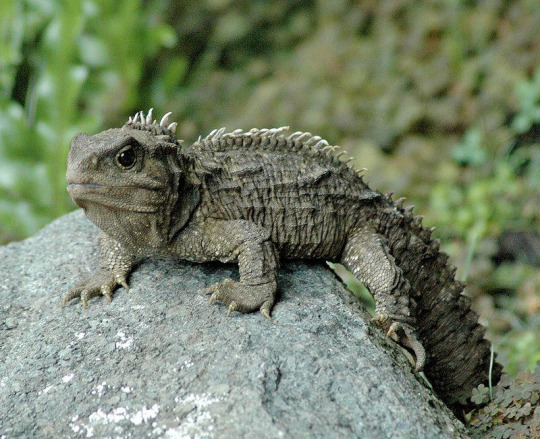
One of the challenges for tuatara conservation is how long it takes them to reach sexual maturity - about 10-20 years, and they tend to have very small egg clutches. They've been recorded to lay up to 19 eggs, but a more typical clutch is as small as 3-6 eggs or even a single egg. These eggs also take over a year to be laid and hatch. They have the slowest growth rates of any reptile, reaching full size at around 30 years and having an average lifespan of around 60 but lifespans closer to 100 not being uncommon.
The oldest known tuatara is named Henry, and he lives at the Invercargill museum on the South Island. He's at least 120 but may be as old as 150, and is still fathering healthy clutches!

Tuatara are simply incredible. They're so unique among living reptiles, and they have so much to tell us about a mostly-extinct order of reptiles. Plus, like, you can't deny they're so cool and adorable!
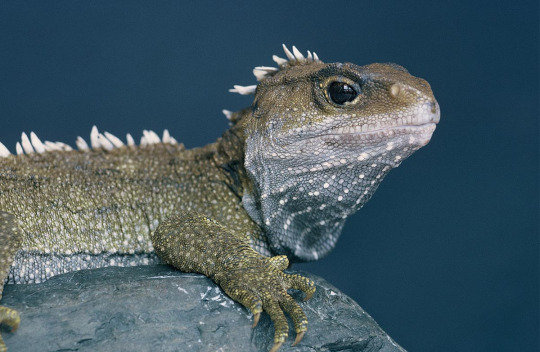
#not a rating#tuatara#tuatara anatomy#sorry for the long post. being asked to talk about tuatara awakens something within me#long post
363 notes
·
View notes